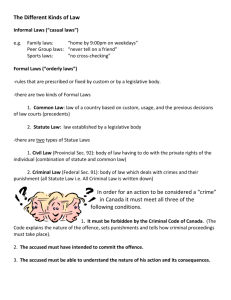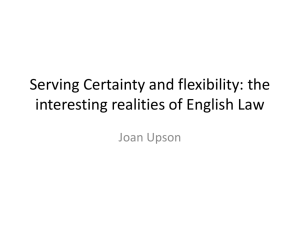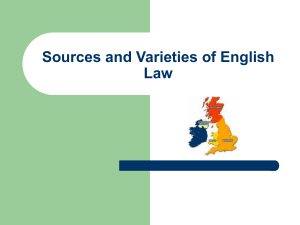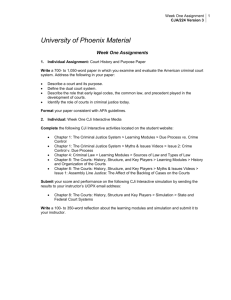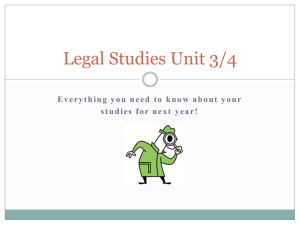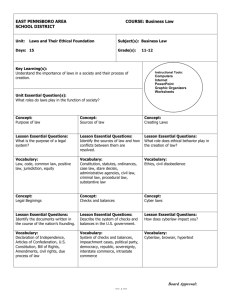Common law developped gradually throughout the Middle Ages
advertisement
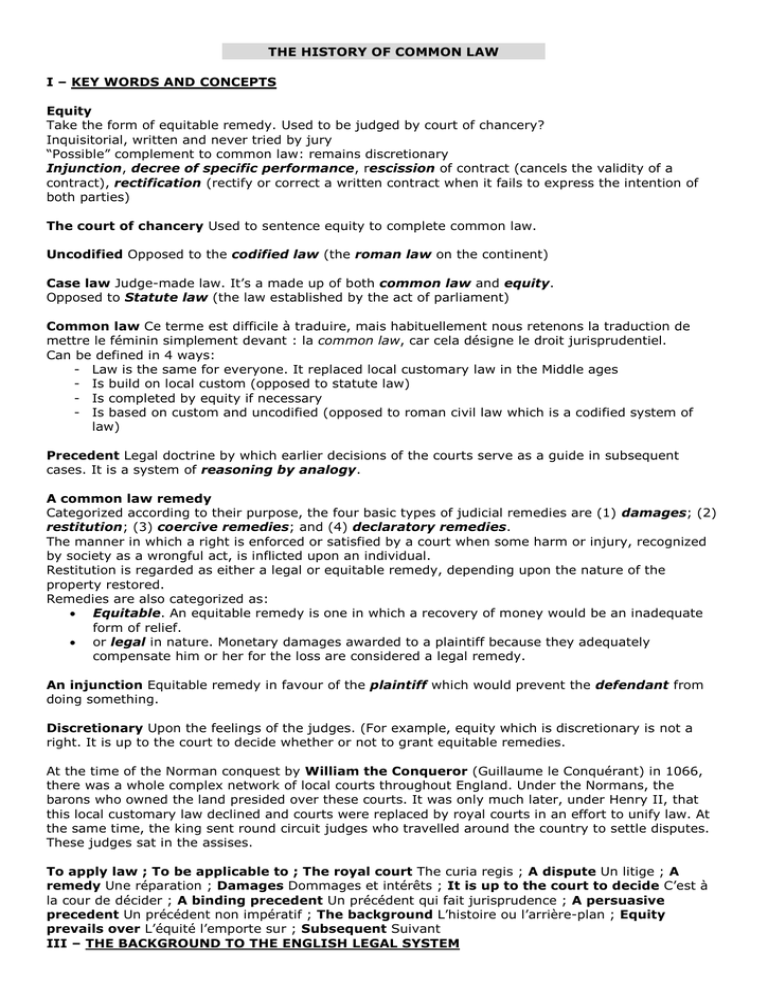
THE HISTORY OF COMMON LAW I – KEY WORDS AND CONCEPTS Equity Take the form of equitable remedy. Used to be judged by court of chancery? Inquisitorial, written and never tried by jury “Possible” complement to common law: remains discretionary Injunction, decree of specific performance, rescission of contract (cancels the validity of a contract), rectification (rectify or correct a written contract when it fails to express the intention of both parties) The court of chancery Used to sentence equity to complete common law. Uncodified Opposed to the codified law (the roman law on the continent) Case law Judge-made law. It’s a made up of both common law and equity. Opposed to Statute law (the law established by the act of parliament) Common law Ce terme est difficile à traduire, mais habituellement nous retenons la traduction de mettre le féminin simplement devant : la common law, car cela désigne le droit jurisprudentiel. Can be defined in 4 ways: - Law is the same for everyone. It replaced local customary law in the Middle ages - Is build on local custom (opposed to statute law) - Is completed by equity if necessary - Is based on custom and uncodified (opposed to roman civil law which is a codified system of law) Precedent Legal doctrine by which earlier decisions of the courts serve as a guide in subsequent cases. It is a system of reasoning by analogy. A common law remedy Categorized according to their purpose, the four basic types of judicial remedies are (1) damages; (2) restitution; (3) coercive remedies; and (4) declaratory remedies. The manner in which a right is enforced or satisfied by a court when some harm or injury, recognized by society as a wrongful act, is inflicted upon an individual. Restitution is regarded as either a legal or equitable remedy, depending upon the nature of the property restored. Remedies are also categorized as: Equitable. An equitable remedy is one in which a recovery of money would be an inadequate form of relief. or legal in nature. Monetary damages awarded to a plaintiff because they adequately compensate him or her for the loss are considered a legal remedy. An injunction Equitable remedy in favour of the plaintiff which would prevent the defendant from doing something. Discretionary Upon the feelings of the judges. (For example, equity which is discretionary is not a right. It is up to the court to decide whether or not to grant equitable remedies. At the time of the Norman conquest by William the Conqueror (Guillaume le Conquérant) in 1066, there was a whole complex network of local courts throughout England. Under the Normans, the barons who owned the land presided over these courts. It was only much later, under Henry II, that this local customary law declined and courts were replaced by royal courts in an effort to unify law. At the same time, the king sent round circuit judges who travelled around the country to settle disputes. These judges sat in the assises. To apply law ; To be applicable to ; The royal court The curia regis ; A dispute Un litige ; A remedy Une réparation ; Damages Dommages et intérêts ; It is up to the court to decide C’est à la cour de décider ; A binding precedent Un précédent qui fait jurisprudence ; A persuasive precedent Un précédent non impératif ; The background L’histoire ou l’arrière-plan ; Equity prevails over L’équité l’emporte sur ; Subsequent Suivant III – THE BACKGROUND TO THE ENGLISH LEGAL SYSTEM English law is applied in: - England - Wales - US (except Louisiana which is still a roman law country) - Influence in Commonwealth (countries which were colonized by the British) Scottish law is based on roman law. Northern Ireland is yet an other system. The United Kingdom (England, Wales, Scotland and Northern Ireland) share a common parliament, which is the sole statute making body. Statute law therefore is applicable in the whole of the United Kingdom. English law is uncodified. It is essentially based on jurisprudence, which affects the whole approach to law, its conceptualization and methods used. The two main sources of English law are: Case law: judge-made law Statute law : legislation, enacted by parliament + community law (European, which often takes precedence over national law). Case law is made up of: - common law - equity Common law has several different meanings: - 1°/ - The Norman commun ley or common law, which replaced local customary law in the Middle ages and made the law common or the same for everyone throughout England and Wales. This was in an effort of uniformity so that the law will be the same throughout the country. - 2° / - Common law built on local custom, as opposed to statute law enacted by Parliament in Westminster. We shall come back to statute law in Unit 2. - 3°/ - Common law as opposed to equity, which evolved in the court of chancery to complete common law. We shall be dealing with that later on in this section. - 4°/ - Common law as a system based on custom and uncodified, as opposed to the codified roman civil law to be found on the continent. a) Case law and the doctrine of precedent There are two parts of a judicial judgement: The ratio decidendi: the reason for the judgement, the reason behind the judgement or the core of the judgement. It is the binding part of a judgment. The obiter dictum: words said by the way or around the central judgement. The ratio is the binding part of the judgement, which means that it must be followed by future courts whether or not they agree with the principle established. Thus it is this part of the judgement which creates judicial precedent. The obiter dicta have only persuasive power. We must note however that it is sometimes a controversal point as to what constitutes the ratio and what the dicta. The case of Donahue and Stevenson in 1932 is one such case. There have been much controversy as to the obiter and the ratio in this case. We’ll come back to that at a later point. The obiter dicta can sometimes have a powerful persuasive effect on subsequent decisions according to importance of the court in which the decision is taken or according to the reputation of the judge concerned. When, for example, a decision is taken in the Supreme court of the USA – an other common law country as we have said above – this decision affects English law. Similarly, the obiter dicta of a prominent judge, one of the Lords of Appeal in Ordinary for instance, it can play an influential role in future decisions. Thus although the obiter dicta is not strictly binding, it combines to make the body of common law progress. b) Common law and equity In the late 15 century, petitions became more numerous. The king delegated his authority to his chancellor and the court of chancery came into being to administer equity. The chancellor was in charge of the great Seal and also of the writ office. His role was to hear cases and to establish decisions, to give fairness – or equity – to give justice to the litigants. The court of chancery functionned side by side with the common law courts until the end of the 19 th century when they were joined. Thus a supreme court of justice was created with one court of original jurisdiction: the high court of justice and one court of appellate jurisdiction: the court of appeal which would hear appeals from the high court of justice. Unlike common law, equity is inquisitorial, written and never tried by jury. Equity complements common law: it does not crush it. It provides then a complementary remedy to common law when common law alone fails to remedy a situation. Even today, however, equitable remedies remain discretionary. This means that equity is not a right: it is up to the court to decide whether or not to apply such a remedy. We must bear in mind the equitable maxim: he who comes to equity must come with clean hands. In other words, if someone asks for an equitable remedy, then he himself must be blameless, he himself must have clean hands. Common law and equity are now judged in the same court and have been since the Judicature Acts of 1873 to 1875. A common law remedy sometimes requires an equitable remedy to complement it. We could take the case of Miller v. Jackson from 1964. In passing we may note that Miller and Jackson is written Miller v. Jackson; the v. stands for “versus”. When we write it, we write a v.; when it is said, it is Miller and Jackson in a civil case in England. The plaintiff, Mr Miller, bought a house next a cricket club. Once he was living in the house, he realized that cricket balls constantly came over the fence and spoiled the enjoyment of his garden. During the cricket season, he couldn’t sit there in peace and his plants and flowers were spoiled by the cricket balls. The cricket club built a very high fence, a 15 foot fence between the two pieces of property. But the balls continued to go over it. Mr Miller then decided to sue the cricket club, to take action against them, for private nuisance. He was the plaintiff against the defendant which was the cricket club. While recognizing the individual discomfort in this situation, the court nonetheless took into account the importance of the traditional game of cricket in English life. The cricket club in question had existed for more than 70 years. It was therefore decided that although a common law remedy of damages should be awarded to the plaintiff, it was unthinkable to grant an injunction, an equitable remedy, which would prevent the defendant from doing something, in this case the cricket club from playing cricket. Lord Denning, the van master of the rolls, in his summing up, reminded the court of the principle that public interest must prevail over private or individual interest. In this case, we see that the plaintiff has the satisfaction of having his complaint to be recognized as being valid in law. He receives compensation in the form of money, that is a common law remedy, whilst the cricket club has to pay for the nuisance it causes. But it is recognized as playing an important social function in English life. So we see here that a compromise has been reached by combining common law and equity. In this case, the equitable remedy asked for was injunction. In other cases, it is more appropriate to provide other equitable remedies: For example, a decree of specific performance. In contract, this forces the defendant to carry out an action, unlike the injunction which we have just seen, which forces the person to stop doing something. Secondly, a rescission, a rescission of contract. This cancels the validity of a contract when a mistake has been made by both parties to the dispute. Rectification: to rectify or correct a written contract when it fails to express the intention of both parties. These are just a few of the equitable remedies which come in to complete common law. In which countries of the UK is common law applied? Common law is applied in England and Wales. What are the two main sources of English law? The two main sources of English law are case law and statute law. What is the first definition of common law? The first definition of common law is that it is the same in all the lan. a) Name the two parts of a judicial decision. The first part of a judicial decision is the ratio decidendi and secondly the obiter dictum. b) What is the difference between them? The essential difference between them is that the ratio, the binding part, is carried on by future courts and becomes part of the body of precedent, whereas the obiter has a persuasive role and is not binding. When we say equitable remedies remain discretionary, what do we mean? When we say equitable remedies remain discretionary, we mean that they are not a right. It is up to the court to decide whether or not to grant equitable remedies. In the case of Miller v. Jackson, what were these two parties called in law? Miller is the plaintiff and Jackson is the defendant. What action was taken in that case? In the Miller v. Jackson case Miller sued the cricket club for private nuisance. What decision was taken by the court? Miller was awarded damages, that is a common law remedy, but was refused an injuction which would stop the playing of cricket. Definition of an injunction. An injunction is an equitable remedy which stops or prevents the defendant from carrying out an activity. How long have common law and equity been judged in the same court? They have been judged in the same court since 1875. Common law developped gradually throughout the Middle Ages Cases of common law and equity have not always been judged in the same court. It’s only since 1875 that they have been judged together The chancellor was appointed by the king STATUTE LAW I – KEY WORDS AND CONCEPTS A statute is an act of Parliament. It means legislation. Parliament is the only statute-making body. Parliament is composed of the House of Lords and the House of Commons. A member of Parliament, is often refered to as an MP. A shitf in power Retournement de situation? The pros and the cons. Advantages and disadvantages of delegated legislation by the Paliament - in favour: o much more flexible than statute as it is quicker and it is also easier to change. o people dealing with these rules are more specialized in the specific areas concerned. o it lightens the burden of Parliament, leaving it free for more important matters. - negative side: o civil servants (fonctionnaires) deal with this legislation when traditionally it is elected members of Parliament. o The government minister decides on this, so courts are excluded in case of problems o Delegated legislation cannot always be checked by Parliament as carefully as one would wish. o Therefore it does not always conform to statute itself. A Lord of Appeal in Ordinary or a Law Lord. Juge siégeant à la chambre des lords. - Lord Denning, a well-known Law Lord, reminds us that it is not up to the judges to rewrite the law. If there is a weakness or an error, then Parliament should rectify it. Lord Denning wants to show that each person plays en individual role. The judges interpret what has been written by Parliament. They do not write the statutes; they interpret them. - Lord Atkinson, an other well-known Law Lord stated this meaning of the literal rule. To interpret a text, Law lords use guidelines (internal and external) and rules of interpretations (literal, golden, mischief) Guidelines 1. internal guidelines: Internal aids are elements of the statute itself which show the intention of the legislator. a. the long title of an act and the preambule set out at the beginning which stipulates the aim of the act b. the meaning of the words in context: the ustum generis rule : “of the same kind”, “of the same nature”. According to this rule, where two or more words are followed by general words, the general words must be read in relation to the particular ones. “cattle, sheep and pigs and any other animal must undergo veterinary testing”, “any other animal” in this sentence refers to farm animals bred for human consumption 2. external guidelines, such as taking into account the context in which the act was passed : looking at the parliamentary debats when the legislation is still in the stage of a bill. An edict Un édit ; A task Une tâche ; A bill Un projet de loi ; The scope of a law La portée d’une loi The literal rule. When the judge turns to the literal rule, he looks at the usual everyday meaning of the words in question. He uses the Oxford English dictionary as a reference. Lord Atkinson stated this meaning of the literal rule : “The judge must interpret the ordinary meaning of words unless something in the context, in the aim of the act or in the circumstances of the case indicates that they are being used with a special meaning, different from the usual one”. This rule, as you may guess, is the simplest one. It is used when there is little ambiguity in the text. The golden rule La règle d’interprétation par la logique = règle apagogique This rule is an extension of the literal rule. It is used when, by applying the literal rule, it clearly makes the text absurd or contradictory or when it reveals some inconsistency in the text. The mischief rule La règle d’interprétation téléologique This rule looks back to the past to try to find out what mischief or wrong the act was made to remedy initially. Here we must ask a series of questions: 1. Firstly, we must ask ourselves what was the situation in common law before this act was passed. 2. Secondly, we must ask in what ways was the common law defective. 3. Thirdly, we must look to what remedy was proposed by the statute. 4. And finally what was the real reason for that remedy? By way of case stated Par l’exposé des faits To mislead someone Induire en erreur The statute which stipulated that the king was not allowed to levy taxes without his council was Magna Carta in 1215. Parliament was established as being the sole law-making body by the Bill of Rights in 1689. The king who made the record number of statutes was Henry VIII, who reigned from 1509 to 1547. By the Act of Supremacy in 1535 the king was made head of the Anglican church. One can find the aim of an act in the preambule. A synonym for “to interpret” is “to construe”. Well, there are many reasons. The first is that statute is often vague. The second will be that the act is dated, the social situation is no longer the same. Thirdly the language may not be clear because the statute is badly written or, finally, the language has an other meaning compared to when the statute was made. The three rules used by judges to interpret statutes are the literal rule, the golden rule and the mischief rule. This form of legislation became necessary to lighten the task of Parliament. The drawbacks of delegated legislation are that it is dealt with by civil servants and not by elected members. Thus the courts are excluded if there is any problem and, finally, it is not always checked as carefully as one would whish by Parliament. a) The history of legislation In the Middle Ages the judges built common law but the king also issued edicts. Magna Carta, in 1215, is a statute which specifies that the king could not levy taxes without the consent of the Common Council of the realm. The first English parliament was in 1265. But it was not until the Bill of Rights, in 1689, that parliament was established as being the sole statute-making body. As parliament became stronger, the power of the monarch was weakened. So from a situation of absolute monarchy in the Middle Ages, there has been a steady shift of power : power has moved from the monarch to Parliament. Today the Queen Elisabeth II reigns, but does not rule. Power lies with the elected body of the people, the Commons in Parliament, in this system of constitutional monarchy in Great Britain. Parliament with the monarch, the House of Lords and the House of Commons, who voted laws, only came into being in the 15th century. Before that, the king could change the laws voted by Parliament. Under the reign of Henry VIII, who was king from 1509 to 1547, there were more laws made than in the previous five centuries. In all there were 677 laws made under that king : a record number indeed. A notable statute under Henry VIII was in 1535 the Act of Supremacy, in which the power of the pope in Rome was rejected as a religious power in England. The king Henry VIII then became the head of the Anglican Church by this Act. Thus the Protestant religion of England became an established one, undissociable from the state. The monarch was head of state and head of church and still is today. The next great period of statute-making came in the 19th century. The industrial revolution meant that, with the advent of railways and factories full of new machinery, new situations had occured and statutes then provided protection for workers and employers alike. Common law does not cover every situation as we have seen, so statute is necessary to complete it or to cover a specific point. Judges then consider statute as something which comes to fill in the gaps in the vast body of law esthablished by the courts : common law. Legislation then does not generally fundamentally change common law. CRIMINAL LAW AND CIVIL LAW AND THE COURTS I – KEY WORDS AND CONCEPTS CIVIL CASE : Civil law regulates the legal relationships between individuals or bodies. It looks in fact to find compromise and to re-establish a satisfactory legal relationship between the parties. A plaintiff ; A defendant ; To sue someone or to take action against someone. The plaintiff sues the defendant. Breach of contract manquement à un contrat. When the plaintiff wins the case, we say that there has been a judgement for the plaintiff and he can expect to receive damages (cf fiche 1) in common law or the judge may even issue an injunction as an equitable remedy (cf fiche 1). The defendant therefore in this case has committed a civil wrong (for example when he has failed to keep his side of the bargain remplir sa part du contrat) and is liable to (redevable) the plaintiff. Miller v. Jackson. This is written v. for versus Jackson, but we pronounce it and. This is generally how civil cases are cited with the plaintiff first, followed by the defendant. If the Queen is a party in a civil case, she is simply called the Queen as, for example, “Smith v. the Queen”. CRIMINAL CASE : Criminal law regulates the legal relationships between individuals or bodies and the state. Il aims at establishing the guilt of a person who has committed a crime and punishing him for this. The vocabulary of guilt and punishment is used in criminal law. A prosecutor prosecutes a defendant. To plead guilty or not guilty: If the defendant is found guilty for a criminal offence, he will be punished according to the seriousness of that crime and we remember that the punishment fits the crime committed: the punishment must be in accordance. In criminal cases, the Queen becomes the latin Regina, abbreviated to R. and, if it is a King on the thrown, then the King, in latin Rex, is also abbreviated to R. Therefore we see a criminal case cited as “R. v. Smith”. And this is how we say it also. There are three kinds of proceedings in the Magistrates’ court. 1. Summary proceedings, dealing with summary offences. These summary offences are the least serious of criminal offences, what we call petty crimes, such things as petty theft, or minor motoring offences, or begging in public places. Now if the accused pleads guilty, the court does not need to hear evidence and it will pronounce his judgement. If he pleads not guilty, the court will hear the evidence and the parties and then convict of dismiss the accused. The maximum penalty in this kind of court would normally be a six-month prison sentence or a fine of no more then about 100 pounds. 2. Committal proceedings. They deal with more serious offences such as murder and rape. The accused first appears in the Magistrates’ court (lowest court in the hierarchy which has both civil and criminal jurisdiction) where the magistrates will decide if there is enough evidence to put the accused on trial by jury (jugé par jury) ; this is known as a prima facie case. The offence in this case is an indictable offence and would be heard in the criminal court in a trial by jury. 3. Offences trialable either way. This means that the magistrate must give his opinion on whether the case should be tried by jury in the crown court or be tried summarily. He may also give the accused the choice, depending on the particular case. Interestingly, a magistrate is more likely to convict than a jury in the crown court (criminal court). If we look at overall statistics, most people, if they’re given the choice, would prefer to be judged by their fellow citizens who make up a jury. We’ll come back to the question of juries at a later date. Trial by jury Formal examination of the facts of a case in court to decide the validity of a charge. Superior courts bind inferior courts Trespassers will be prosecuted. Quite wrong : trespass is usually a civil wrong ; there are certain specific cases in which it can be a criminal act but, usually, trespass is a civil wrong because it is most often a simple question between the individual property owner and the person encroaching on his land. So the correct formula should be : Trespassers will be sued, as the state prosecutor plays no part in such proceedings. Tribunals Les tribunaux (not in the court system) ; A contractual agreement Un accord contractual ; A shop owner Un commerçant ; A rape Un viol ; A manslaughter Un meurtre sans préméditation ; A fine Une amende ; A built-up area Une agglomération ; To knock someone over Renverser quelqu’un ; A bankruptcy Une faillite a) Criminal law For this, offences are put into different categories when they are being dealt with in the courts : 1. Class 1 offences are, for example, murder and treason against the state and these are always judged by a high court judge 2. Class 2 offences include manslaughter, rape and infanticide , so are still extremely serious and are often tried also by a high court judge, but can also be heard by a circuit judge or recorder just like class 3 offences 3. Class 4 offences may be tried summarily by circuit judges and recorders. Although both are clearly distinct, we may find ourselves in both a civil court and a criminal court for the same action. We must also note in passing that for this same action the consequences are different. In the criminal case you will probably be fined and perhaps even lose your license whereas in the civil case you will probably have to pay damages to the individual who has been injured. III – B/ COURTS AND TRIBUNALS a) Tribunals Tribunal are bodies which exist outside the hierarchy of the court system. Their function is to lighten the burden of the courts by dealing with cases in a less formal way. This means that decisions are given more quickly, the cost is lower and the procedure simplified. There are two main kinds of tribunal. 1. Domestic tribunals dealing with professional bodies which serve as disciplinary bodies within given professions. For example, for barristers the body in question is the General council of the bar or for doctors the General medical council which ensures internal discipline within the professions. 2. Administrative tribunals, which are established by the state, unlike domestic tribunals. They are usually set up following an act of Parliament and the government minister concerned is responsible for them. These tribunals deal with such areas as problems between tenants and landlords for rent tribunals or between employers and employees and industrial tribunals. They function as autonomous bodies at first instance, but any appeal made on a point of law must go through the courts of law since the tribunal’s role must remain administrative. Even though they function according to the common law model of precedent, they do not, at least officially, make law. b) The court system: shéma The court system is hierarchical. Lower courts are bound by higher courts. Court procedure is accusatorial, which means that evidence is presented to the judge by the parties and he reaches his decision based on that evidence. This system is known as the adversarial system. Look at the blank diagram in your handout. As you listen, fill in this diagram as you go along so that follow step by step the hierarchy of the English court system. If you look at this diagram, you see that its divided into two parts, left and right, and it goes from the bottom to the top. We are going to follow this diagram from bottom to top. If you look at the box right at the bottom, which goes over the two sides, which goes over criminal and civil proceedings, it is the Magistrates’ court. The Magistrates’ court deals mainly with criminal cases but also has civil jurisdiction. Nowadays more than 95% of criminal cases are dealt with in this court. Criminal proceedings Move up on the diagram, on the left-hand side, for criminal proceedings. As we move up, you can see a series of arrows which show you to which court we can appeal, to which court lies the appeal. On the left-hand side, just above the Magistrates’ court, is the crown court. It is a court of first instance, when committal proceedings in the Magistrates’ court have referred the case to it. It can also be appellate : it can also be an appeal court, which receives appeals from the Magistrates’ court. So it has two functions. All indictable offences to which the accused has pleaded not guilty in the Magistrates’ court are dealt with in this court and tried by jury. When the crown court is in London, it is called the Central criminal court or the Old Bailey. The court of appeal is divided into two : the criminal division (on the left) and the civil division (on the right). The criminal division of the court of appeal receives appeals from the crown court. You cans see the arrow going from the crown court up to the criminal division of the court of appeal. We say that appeal from the crown court lies to the court of appeal. If appeal is successful, the conviction will be washed. On the left of the diagram is the divisional court of the Queen’s bench division, which mainly plays a supervisory role. Finally, at the top of the diagram, you will see the House of Lords. This is the ultimate court of appeal with a very precise and limited number of criteria of those which to be judged there. Civil proceedings Now look back down to the right-hand side of the diagram, starting to the bottom again going up. At the bottom, you see the Magistrates’ court which we’ve already seen in criminal proceedings. It deals mainly with criminal matters ; it does however deal with some family law, particularly since the 1989 Children’s Act. It also deals with licensing matters for pubs, restaurants, cinemas and theatres. Just above this box , on the right-hand of the diagram, is the county court which deals with all civil wrongs, except family law. It mainly deals mainly with the law of contract and tort (= wrong); it deals with land questions, property, estates, inheritance, all within certain financial limits which are set out in the County Courts Act of 1984. The county court also has a small claims court that deals with all the rather minor claims for debts. Civil proceedings If we move up the diagram to the superior court, we find the high court of justice and this by far is the most complex court. It is divided into three parts. If we go from left to right in the high court of justice, we have the Queen’s bench division, the chancery division and finally the family division. This court dates from the Supreme Court of Judicature Act in 1873 and has been regularly reorganized since then. The Queen’s bench division deals with habeas corpus writs and judicial review mainly. The chancery division deals with land and mortgages, bankruptcy and estates. The family division of the high court, as its name indicates, deals with matrimonial issues, with custody of children and adoption. The court of appeal in a civil division is to be found as we move up in the hierarchy of the courts. We will see it in the box just above and it is the one which is divided into two, into civil division and criminal division. This court judges appeals from the high court and from the county court. Finally, at the top to the diagram is the ultimate court of appeal : the House of Lords, which hears only a restricted number of cases. The main criteria for a case to be brought before the House of Lords is that it should deal with a point of law of general public interest, which can be elucidated only in the House of Lords. These cases always concerned with general principles such as, quite recently, the Pinochet affair, which goes beyond simply the individual being judged. They create a precedent which will be important and referred to in future cases. We have just looked briefly at the court structure in England and Wales, which, as you can see, is hierarchical : superior courts bind inferior courts. Until recently, the House of Lords binds itself. There is, of course, nowadays a further recourse after the House of Lords, outside Britain. All matters concerning the construction or interpretation of the Treaty of Rome may then be judged in the Court of Justice of the European communities, which binds even House of Lords. IV – USE OF ENGLISH Criminal law is the law which regulates the legal relationships between individuals or bodies and the state. Civil law is the law which regulates the legal relationships between individuals or bodies. Case study : James Bean has held up a bank, threatening the employees with a loaded gun. One of the employees panics and presses the alarm button. James Bean fires and wounds two people in the bank. This is not his first offence. Comment on what would happen if he were arrested. James Bean is a bank robber or a potential bank robber, who has committed armed robbery. He has clearly committed a crime, but has not only committed a crime but also is liable in civil law. He would appear before the Magistrates’ court and then probably be tried on indictment before the crown court. The individuals who were injured in this situation could also sue him in the civil court. James Bean is in a rather big trouble here ! What are the two kinds of tribunal ? The two kinds of tribunals are the domestic tribunals and the administrative ones. Which cases are heard in the criminal division of the court of appeal ? The cases that are heard in the criminal division of the court of appeal are appeals from the crown court. What is the main criterion for a case to reach the House of Lords ? The main criterion if you want a case to reach the House of Lords must be on a point of law, on a matter of public importance and interest. It mustn’t just be an individual issue; it must be one which is of some interest and some good to the public. Which court has needed to be regularly reorganized ? The court that has been regularly reorganized is the high court of justice, which is a very complex one. Where are bankruptcy cases dealt with ? Bankruptcy cases would be dealt with in the chancery division of the high court of justice. The language of debate. Agreement and disagreement If you mildy agree with someone or you don’t really mind, you would say : I don’t really mind one way or the other. Or you could say : I would tend to agree with what you say, but ... and perhaps introduce then something which disagrees. I take your point, but I can’t help feeling that it would be better to do something else. On the whole I would agree with you, but... and introduce again a countered argument. Then we come to disagreement : You can’t seriously believe that a statute would change people’s attitudes. I really can’t agree with such an extreme point of view. I totally disagree with you. I really must beg to differ : this is the much more formal way of disagreement It’s no use pretending we’ve changed our minds on the subject.

